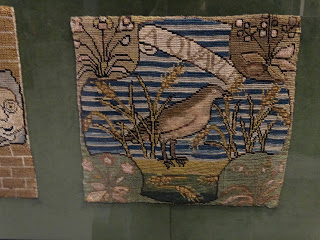A trip to the Victoria & Albert Museum - I was tired and sore but managed to get around some of the museum before I had to say no more.
This magnificent beast is a tomb horse from the Eastern Han dynasty. He is hollow, made of several large moulded parts and covered with an amber lead glaze.
This beautiful piece of embroidery is a Daoist Priest robe from the Qing Dynasty.
Another robe for a Daoist Priest, also from the Qing Dynasty. I am in awe of the hand embroidery and the goldwork.
A gorgeous Imari dish showing a woman in a garden with two attendants.
Gorgeous Japanese vase with swimming carp.
A kimono made using the kasuri technique, thread is space dyed with indigo and the pattern emerges as it is woven.
A Sweet Lolita outfit from a Japanese company, with Alice in Wonderland motifs.
A dragonfly netsuke. Kimono don't have pockets, men would carry every day items in containers suspended on a silk cords from the obi (sash).Netsuke were used as a toggle to hold the cords together.
Another beautifully embroidered kimono design, probably from the ruling family. The embroidery is in silk and metal threads.
An outer kimono decorated with satin silk applique, with embroidery in silk and metallic threads.
A magnificent cast bronze incense burner. I have a fondness for peacocks and this is a stunning representation of that majestic bird.
A fabulous oak spiral staircase.
19th century Gothic Revival style cast iron tabernacle grill. Inspiration for blackwork embroidery?
German wrought iron window grille, another pattern that could easily translate into blackwork.
18th century wrought iron gate from Germany.
Wrought iron lunette grille, also from Germany.
These embroidered panels were the work of Mary Queen of Scots, along with Bess of Hardwick and the ladies of her household during her imprisonment, the large central panel was probably made at Tutbury Castle in Staffordshire. Other panels remain at Oxburgh Hall in Norfolk. Gold, silver and silk threads on linen canvas in tent stitch.
This carpet was used as a table cover in the Great Hall of Sir Edward Apsley's house at Thakeham in Sussex, dated 1603. I was particulary struck by the celtic knotwork border.
Absolutely stunning embroidered casket dating from 1650-80. To protect it mica panels were used to cover it and held in place by the metal braid. The mica is transparent and very delicate but is still in place. Wow!
English bed curtains, linen and cotton twill embroidered with wool, dating from 1690-1710.
Indian bed curtain made from painted and dyed cotton (chintz), dating from approximately 1700.
A wall hanging, one of six that decorated a house in Hatton Garden, London dating from 1650 - 1700. Linen canvas embroidered with wool.
Abigail Pett's bed hanging, one of ten panels dating from 1680-1700. The leaf design is reminiscent of Indian textiles. Crewel wool embroidered on linen and cotton.
It's a mirror with a kingdom, well not quite. If you haven't read the story of the mirror with the kingdom on top, check it out here...
Beechwood couch dating from 1805, what I wouldn't do to have a lounge that I could fit this beauty in.
Alan had to try on the Inverness Cape. I think he wants one, wonder if I could find a pattern for one somewhere and spiff up my dress making skills enough to make one.
From the 1851 Great Exhibition, this baby's gown is hand knitted from sewing cotton. Another mind blown moment. And it only won the bronze medal in its class.
Hand painted graph for jacquard loom weaving.
and a few London landmarks on the Uber ride to the train station. Buckingham Palace, the Houses of Parliament and Big Ben.









































































No comments:
Post a Comment